Japanese honeybees are a subspecies of the Asian honeybee native to Japan. But although honey is a kitchen staple in Japan as in many other countries, most of the honey is imported, and even the domestic honey is largely produced using European honeybees. The island of Tsushima retains a thriving population of Japanese honeybees and is home to a growing honey industry.
Encroachment of European Honeybees
Today honey is widely recognized as a healthy food. About 95 percent of the honey consumed in Japan is imported, however, according to the book Mitsubachi ga naiteiru (The Honeybees Are Weeping) by Jiro Ueno. Beekeepers are on the decline, not only due to the inundation of imported honey but also because honeybees are susceptible to weather anomalies and pollution. Today pure, unprocessed domestic honey has become something of a luxury product.
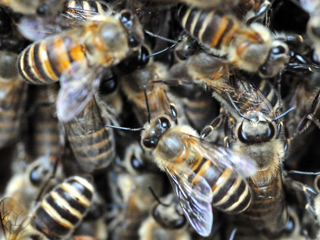
Especially rare is honey produced by Japanese honeybees, which accounts for less than 10 percent of domestic honey. But until European honeybees were brought into Japan in 1876, all domestic honey was produced by this native breed, a subspecies of the Asian honeybee.
Seita Fujiwara, a beekeeper from Iwate Prefecture, has an explanation for the depletion of Japanese honeybees. Fujiwara is a long-time admirer of the native bee, having launched the Japanese Original Honeybee Organization during his student days at the Tokyo University of Agriculture. In his book Nihon mitsubachi (The Japanese Honeybee), he gives two advantages of European honeybees that make them more efficient than their domestic counterparts. The first is that the former, being somewhat larger than the latter, are able to collect four to five times as much nectar. The second advantage is that they were introduced to Japan along with revolutionary hive management techniques. Western-style beekeeping involves the use of hive frames that can be pulled up from the box in which they are kept and then put back in place. Beekeepers can easily inspect the hives, and harvesting the honey takes only minutes. With traditional beekeeping, by contrast, in which hollow logs are commonly used as hives, the hive tops must be broken to extract the honey, killing the larvae and eggs in the process.
Reappraisal of Japanese Honeybees
After being stigmatized for many years as an inferior honeybee, Japanese honeybees are finally being seen in a better light. Hiroshi Aiba, a beekeeper in Tsushima, Nagasaki Prefecture, describes their virtues.
"European honeybees are good at collecting the nectar of one plant species, but Japanese honeybees move about nimbly and literally collect the nectar of a hundred different flowers. Also, whereas honey produced by European honeybees is harvested several times in the spring and summer with the blossoming of different flower species, that of Japanese honeybees is harvested only once a year in the fall. This gives time for the honey to slowly mature and enhance its medicinal properties."
Research has proven various advantages of Japanese honeybees. First, they are resistant to such infectious diseases as foulbrood and chalkbrood. Second, they know how to fight Japanese giant hornets and other intruders. European honeybees are defenseless against giant hornets, which were absent in their native habitat, so that a small number can devastate an entire colony. But Japanese honeybees immobilize invading hornets by attacking them in large groups, form a ball around them, and heat them to death by vibrating their flight muscles so that the temperature in the ball rises to around 47 degrees Celsius.
Third, Japanese honeybees are resistant to cold. European honeybees are unable to move about in temperatures below 11 degrees, being descended from bees native to Africa, but Japanese honeybees will harvest pollen in lower temperatures if needed.
Fourth, and most of all, Japanese honeybees are small but agile. They diligently go about collecting the nectar, pollen, and juice of various plants, giving their honey a profound flavor.
Beekeeping in Tsushima
Japanese honeybees inhabit most of Japan, and apiaries of these bees are scattered across the country, including the prefectures of Nagano, Gifu, Saga, Miyazaki, and Tokyo. Tsushima, in particular, has an islandwide tradition of beekeeping with Japanese honeybees. Part of Nagasaki Prefecture, Tsushima is situated 48 kilometers from the Korean Peninsula and 40 kilometers from the Port of Hakata. Here, people still produce honey by the ancient method of using hachido, or log hives.
The following roughly describes the cycle of a Tsushima beekeeper's work.
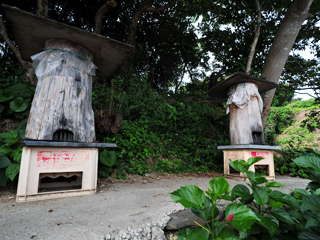
1. Preparing log hives
Logs for use as hives are cut to a height of about 70 centimeters and bored to a diameter of 22 to 23 centimeters. Cryptomeria or cypress wood is used. Three cigarette-size pathways are made; larger holes will permit the entry of hornets. Nectar is applied on the inside.
2. Selecting an ideal location for the bees
A suitable location for log hives, where swarming bees--bees that have left their original colony to form a new one--are most likely to enter the logs, is somewhere that provides a clear view in front but is backed by a large tree or rock. Log hives should also be sheltered from the rain and from direct sunlight. The most ideal site is an east-facing location that receives sunlight in the morning but not in the afternoon.
3. Capturing swarms
Part of the colony will depart to form a new colony, a behavior called swarming, between mid-April and May. Beekeepers know that the time is near when the bees get restless and begin flying up and down around the log hive. They track the swarm and hang a nectar-dabbed, netted bee cage where the bees have headed, which may be a tree branch in the mountains or the eaves of a house. With the rest of the swarm obediently in tow, the cage housing the queen bee is carried to the logs that have been prepared for them. Plastic must never be used, as they can cause temperatures to rise to lethal levels. Many beekeepers in Tsushima use an orchid native to China called kinryohen to attract the swarm.
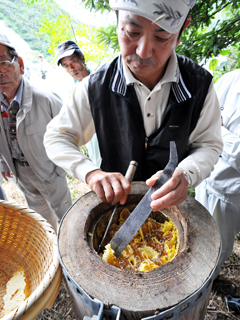
4. Monitoring the beehive
Unlike movable frame hives, the inside of log hives cannot be easily inspected. But the beekeepers of Tsushima, with their trained instincts and by observing the behavior of the bees flying around the hive, are able to grasp the conditions inside the hive and the presence--or absence--of hornets and hive pests, the two major enemies of honeybees on this bearless island.
5. Harvesting honey
Honey is harvested only once a year. Japanese honeybees construct their hives downward from above in the first year and upward from below in the second. In the fall, beekeepers cut out half--or a third in the case of some people--of the beehive using a special knife, leaving the remainder intact. This is done while calming the bees with smoke generated by burning hemp or other fuel in a smoker. Whereas most commercially available honey, particularly imported products, have been heated to increase sugar content, Tsushima honey is not heated so as to preserve its aroma and medicinal properties.
A Budding Honey Industry
November 2007 marked a milestone in the island's honey industry and in the history of Japanese honeybees: the Tsushima City Japanese Honeybee Committee was launched to organize beekeepers across the island. As of 2008 the committee had 61 members, most of whom are also members of the Tsushima Forestry Cooperative. The committee aims at elevating what had been produced on a subsistence basis to the status of a local brand, thereby supporting the livelihood of members who have been hit by low lumber prices.
"What really struck me after growing an interest in Japanese honeybees was the abundance of flowers in Tsushima," says Tsugio Ogi, president of the forestry cooperative. With rough mountains covering 90 percent of its land area, Tsushima hosts many rare native plants: Genkai tsutsuji, a rhododendron variety; hitotsubatago, the blossoms of which make the mountains glow white in May; inuzansho, a prickly shrub of the citrus family; yamazakura, a variety of Japanese cherry; yabutsubaki, or Japanese camellia; and kaki, or Japanese persimmon, to name but a few. And around harvest time in October, the bees can be heard buzzing animatedly around the white buckwheat flowers carpeting the valleys.
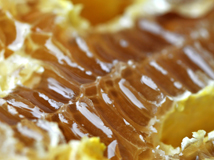
The beekeeping culture of Tsushima not only helps conserve Japanese honeybees but also leads to the protection of the local flora, whose myriad flowers variously adorn the island through the seasons. Furthermore, the honey of Japanese honeybees possesses a complex and profound flavor and aroma that are entirely distinct from those of honey produced by their European cousins. Honey is the key to the good health of islanders, who have a custom of eating it every day. They also have traditionally used honey as a sauce for freshly pounded rice cakes.
The Universal Value of Indigenous Species
According to a fact-finding survey conducted following the launch of the Tsushima City Japanese Honeybee Committee, 379 households in the island produce honey using Japanese honeybees. Of these, 69 households have up to 5 log hives, 112 have 6 to 10 hives, 98 have 11 to 20 hives, 47 have 21 to 30 hives, and 53 have 31 hives or more. But the response rate only came to 56.2 percent, and as some directly sell their honey to customers via the Internet, the actual number of producers is estimated to be much higher. What is more, 327 households, or nearly 90 percent of respondents, said that they produce honey for their own consumption or as gifts, suggesting the predominantly noncommercial nature of honey production in the island.
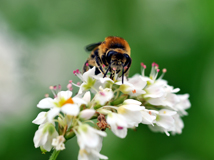
Tsushima is also notable in its absence of European honeybees, thanks to a local tradition of valuing native bees. A greenhouse farm on the island's south side once brought in European honeybees for cross-pollination, but it gave up on the plan when beekeepers complained that their Japanese honeybees would be attacked.
Asked why Japanese honeybees have fared so well in Tsushima while beekeepers elsewhere have switched to the more efficient European honeybees, locals invariably responded, "Because Tsushima is an island." In addition to the island's wealth of nectar sources, that agricultural fields cover less than two percent of the land--meaning that there is little concern for the effects of agrochemicals--likely contributed to the survival of Japanese honeybees. The self-sustaining way of living on the island, though this too is now passing into history, also must have helped preserve the tradition of beekeeping without much thought to its value.
Seita Fujiwara writes in his book mentioned earlier, hoping for the reappraisal of the Japenese honeybee:
Indigenous species are the fruit of a region's ecological balance that has been nurtured over tens of thousands of years, the very "trials and tribulations" that have taken place millions of times as part of the workings of nature. They are coming to attract attention because they possess a universal value like that of an ancient tongue, which no amount of tinkering by humans can create and is irrecoverable if lost in the interest of short-term gain.
Photos: Yoji Kato
